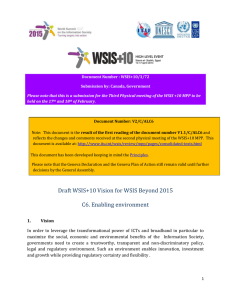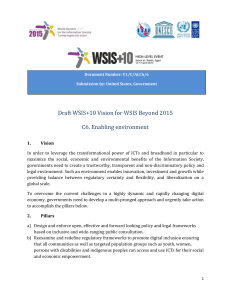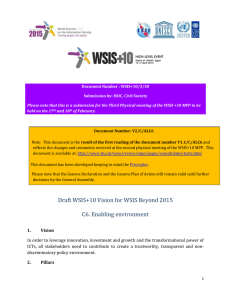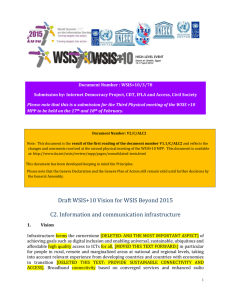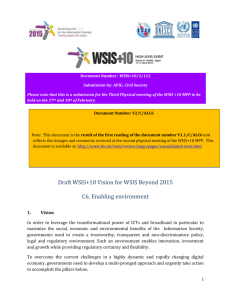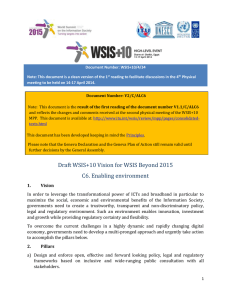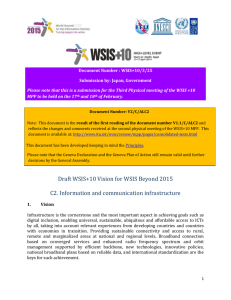Document 13472483
advertisement
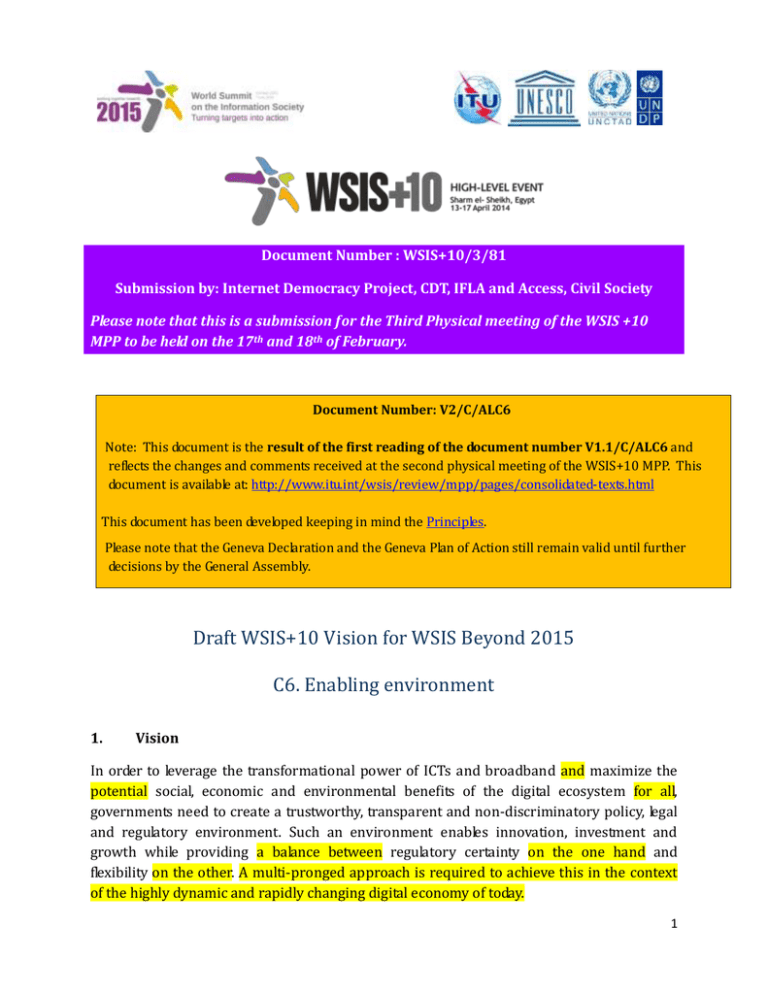
Document Number : WSIS+10/3/81 Submission by: Internet Democracy Project, CDT, IFLA and Access, Civil Society Please note that this is a submission for the Third Physical meeting of the WSIS +10 MPP to be held on the 17th and 18th of February. Document Number: V2/C/ALC6 Note: This document is the result of the first reading of the document number V1.1/C/ALC6 and reflects the changes and comments received at the second physical meeting of the WSIS+10 MPP. This document is available at: http://www.itu.int/wsis/review/mpp/pages/consolidated-texts.html This document has been developed keeping in mind the Principles. Please note that the Geneva Declaration and the Geneva Plan of Action still remain valid until further decisions by the General Assembly. Draft WSIS+10 Vision for WSIS Beyond 2015 C6. Enabling environment 1. Vision In order to leverage the transformational power of ICTs and broadband and maximize the potential social, economic and environmental benefits of the digital ecosystem for all, governments need to create a trustworthy, transparent and non-discriminatory policy, legal and regulatory environment. Such an environment enables innovation, investment and growth while providing a balance between regulatory certainty on the one hand and flexibility on the other. A multi-pronged approach is required to achieve this in the context of the highly dynamic and rapidly changing digital economy of today. 1 2. Pillars a) Design and enforce open, effective and forward looking policy, legal and regulatory frameworks based on inclusive and wide-ranging public consultation with all stakeholders. b) Reexamine and redefine such frameworks [DELETED: MENTIONED IN PARA A ABOVE] to promote digital inclusion, ensuring that all communities as well as targeted population groups, such as youth, women, persons with disabilities and indigenous peoples, can access and use ICTs for their social and economic empowerment. c) Adopt a holistic approach to the development and governance of the ICT sector and move towards cross-sector approaches in view of fueling synergies among government agencies, private sector and the society as a whole. d) Enact a consistent and overarching ICT and/or broadband policy to foster broadband development across all sectors that drives digital inclusion, and implements and monitors related activities. e) Ensure effective and fair competition [DELETED: LEVEL PLAYING FIELD], promote transparency, and create a regulatory framework that nurtures innovation and entrepreneurship while stimulating investment, including foreign direct investment, for the roll-out of broadband infrastructure (including broadband) and the development and uptake of e-applications and services. [COMMENT: DELETED ORIGINAL PILLARS F AND G] f) Recognizing the economic potential of ICTs for Small and Medium-Sized Enterprises (SMEs), contribute to increasing their competitiveness by [DELETED: STREAMLINING ADMINISTRATIVE PROCEDURES, FACILITATING THEIR ACCESS TO CAPITAL, REDUCING THE COST OF DOING BUSINESS AND] enhancing their capacity to participate in ICT-related projects. g) Encourage [DELETED: PROMOTE] the development and adoption of appropriate national, regional and international standards required to foster interoperability and to facilitate the flow of information and services across borders [DELETED: AND ADDRESS THE CONCERNS OF VARIOUS ICT PROVIDERS AND USERS]. h) Develop regulatory measures, including through collaborations at the regional and international levels, to ensure personal and data protection and the protection of 2 consumer rights, including the rights of minors and other vulnerable people, and further enhance national capacities to enforce such measures by growing a professional workforce adhering to the highest ethical standards. i) Encourage the emergence of a [DELETED: ROBUST AND] flexible intellectual property rights framework that balances the interests of creators, implementers and users and generates the necessary regulatory conditions to support long-term access to a rich public domain of intellectual materials allowing for creating, sharing and preservation of cultural heritage to the extent possible in digital form. 3. Targets [COMMENT: DELETED THE ORIGINAL TARGET 1] a) Make broadband policy universal. By 2020, all countries should have a national broadband plan or strategy or include broadband in their Universal Access/Service Definitions. b) Boost the competitiveness of broadband markets. By 2020, all countries should have effective competition in the main broadband market segments (mobile, DSL, cable modem, fixed wireless, leased lines, Internet services, international gateways and Voice over IP (VoIP).) 3

